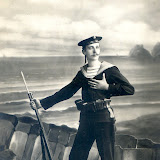Hapsburg propaganda postcards from World War One
Or you'll be dozing safe in your dug-out -
A great roar - the trench shakes and falls about
You're struggling, gasping, struggling, then ... hullo!
Elsie comes tripping gaily down the trench,
Hanky to nose - that lyddite makes a stench -
Getting her pinafore all over grime.
Funny! because she died ten years ago!
It's a queer time.
Robert Graves; “It’s a Queer Time”
Erich Maria Remarque’s All Quiet on the Western Front opens with one soldier coveting another’s flying boots. It sets up a basic image that will run through the novel; the German soldiers - they are about 19 years old - imagine the smallest comfort would make a huge difference. Battle is only one of their tribulations. Boredom, hunger and the pointlessness of the war wear them down just as much. A few chapters later the soldier does inherit the boots, when their owner, Kemmerich, is wounded and has a leg amputated.
This post’s gallery contains thirteen Austro-Hungarian propaganda postcards from the First World War. Every country involved in the war produced postcards extolling the virtuous efforts on their own side and the moral turpitude of the enemy. These particular images use a montage of photography, painting and text to depict the glory of serving your country. Technically they weren’t difficult to produce and could be churned out by the thousands. Even today they are relatively cheap to buy, but their price and availability isn’t what makes them interesting, although perverse may be the more accurate term.
Religion is a common motif in these photographs. A soldier shares bread with two children, guardian angels hover over soldiers, a nun stops to talk to two patients, the nurses wear crosses and crucifixes. But religion wasn’t a cause in the war. Even at Gallipoli the notion that Christians were fighting Muslims didn’t get traction. It’s not surprising though; propagandists always make a connection between dying for your country and dying for God. Religiosity however is not the most macabre element in these photographs.
That dubious honour belongs to their bloodless sentimentality. These soldiers aren’t really wounded. Their bandages and sheets are as pristine as the girls tending them. Perhaps the men in these scenes were genuine soldiers but if so, they were photographed before they’d seen battle. This is war as imagined by little boys, except that the people responsible for these images are adults, who must have had some idea what was unfolding on the front lines. By late 1917 citizens in Berlin were rioting against the war. On the other hand, around the same time, Baumer, the narrator in AQOTWF returns to his hometown and meets a local bore who still regards the conflict as a game of strategy. He at least would have seen no irony in these postcards.
The battles of the Somme, Gallipoli and Passchendaele created a whole new iconography of war. The death’s head and the rotting corpse chased the angels away from the trenches and it was easy to subvert the militaristic aesthetic of sharp diagonals and vibrant colour into morbid satire. By 1916 a Hapsburg soldier seeing a postcard of a soldier and nurse must have been baffled by its simple message. That year George Grosz and Tristan Tzara were using the same collage techniques as in these postcards to produce scabrous indictments. Instead of young, mooning conscripts their central figures were fat industrialists, cripples and dehumanized automatons. Could postcards like these have been an influence on Dada? The media with its raucous and saccharine nationalism was a part of the war machine, and it was a much more accessible target than the generals and factory owners. Whether or not these postcards directly influenced Dada, they were emblematic of the attitudes it damned.
In the late 1920s John Heartfield (born Helmut Herzfelde) began producing anti-fascist posters also using photomontage. In November 1932 he produced one of two skeletons lying in a pit. All that remain of their uniforms are their boots, still in excellent condition. The caption reads, “And again?”
 |
| ALL QUIET ON THE WESTERN FRONT |






Geat post. reminds me of a photo-like painting my grandfather had of a nurse kissing her patient. My father still has it. While utilising the same style, it was satirical. It has a caption along the lines of "unconventional medecine" or something.
ReplyDeleteLove this blog John.